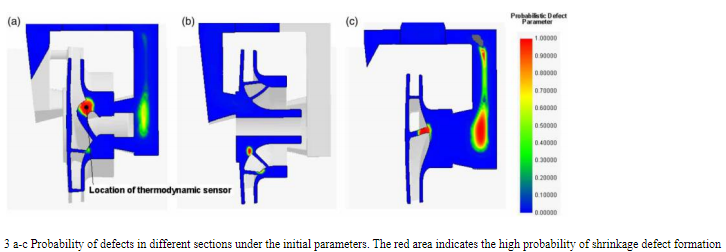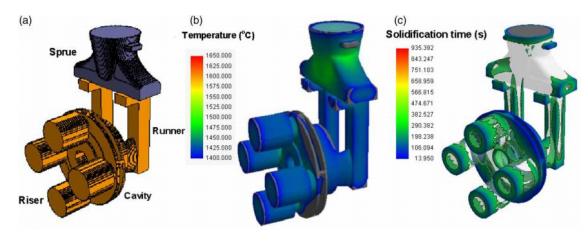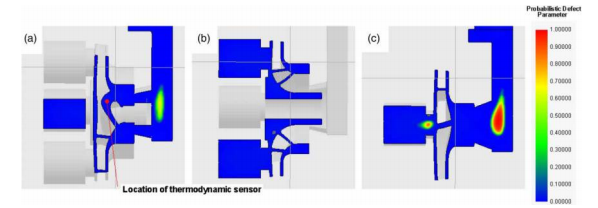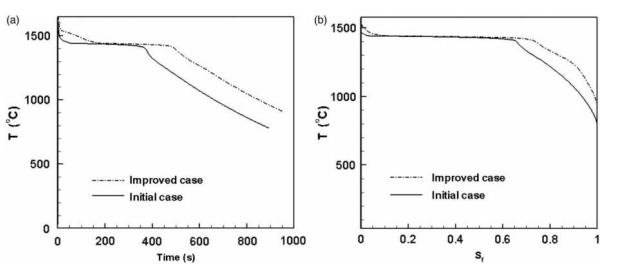
Improve pouring system design and pouring conditions
In the previous section, due to the insufficiency of the gating system, it was unable to provide sufficient feed, and the initial pouring parameters resulted in shrinkage and dispersive shrinkage. Therefore, the structure with uneven thickness and local temperature must be improved. Considering that areas with large structural wall thickness changes are prone to residual stress and deformation, we replaced the runner gating system on the blade with a riser on one side to cope with rapid cooling and incomplete feeding. In coordination with the riser, we place the runner directly above the runner. In addition, the design of the riser must meet the energy standard. 7 This means that the solidification time of the riser and the neck of the riser must exceed the solidification time of the mold cavity to ensure that the feed channel remains unobstructed. In order to enhance the feeding function, the riser is horizontal, which can provide a smooth feeding path and
The shortest feeding distance to the casting. In addition, to ensure that there is a sufficient amount of molten metal to fill the casting defects, the size and volume of the riser must conform to the following formula 8:

In the formula, V1, V2, and V3 respectively represent the volume of the riser (mm3), the volume replenishment requirement of the casting and the final solidification volume of the riser, and β represents the solidification shrinkage coefficient (%) of the cast alloy. We will use equation (2) (size: 60 (d) × 60 (h) mm) to design four risers on the left side of the impeller hub to play the role of feeding. Figure 4a shows the design details of the gating system, which contains 4002480 cells in total. Use Tcasting = 1650 and Tceramic = 1250°C. Figure 4b shows the transient phenomenon of molten metal flow at t = 2.2 seconds. As shown in the figure, the riser significantly reduces the effects of flow and turbulence near the thin wall, thereby reducing the possibility of pores. In addition, analysis of the coagulation time indicated that the total coagulation time increased from 882.5 seconds to 935.4 seconds. The addition of the riser reduced the solidification time near the thin wall from 320 seconds to 300 seconds. The solidification time of the neck of the riser (t = 440 seconds) exceeded the solidification time of the initial shrinkage cavity area (t = 150 seconds). These Changes make it possible to successfully complete feeding.

4 Improve the physical model of the pouring system; b t = 2.26 seconds of the transient flow of molten metal during pouring; c t = 252.6 seconds of transient solidification

5 a-c Improve the probability of defects in different parts of the gating system, the color represents the probability of defect parameters

6 Relationship between: temperature-time; b temperature-solid fraction obtained from thermodynamic sensor. 3a and 5a
Analysis of thermodynamic behavior under the initial plan and the improved plan
Figure 5 illustrates the probability of occurrence of defects using the various parts of the improvement scheme. As you can see, the redesigned gating system significantly reduces the possibility of shrinkage in thin-walled areas. This can be attributed to the addition of risers and higher pouring temperature. In order to determine the cause of the casting defects under the initial parameters, we installed a thermodynamic sensor near the thin wall of the impeller blade to perform temperature time and time-solid content analysis, as shown in Figure 1 and Figure 2. 3a and 5a. The result is shown in Figure 6. As shown in the figure, the temperature of the defect location using the initial casting scheme drops to a solidus temperature of 1400°C earlier than the temperature at the same location using the improved scheme. The former starts to fall below the solidus temperature at 390 seconds, while the latter does not do so until 500 seconds. Obviously, if there is no riser, the initial gating system will cause the secondary dendrites in the impeller structure to solidify too quickly. This leads to insufficient feed in the blade, resulting in the formation of shrinkage pores. Figure 6b shows that when the solid fraction of the initial pouring is 70%, this solution causes the temperature to drop from 1400°C, but under the improved pouring system, this does not happen until the solid fraction is 78.5%. We infer that under the initial pouring conditions, the excessively rapid temperature drop at this location increases the flow resistance. Although the improved pouring system prolongs the overall solidification process, it significantly improves the pouring effect. Molten metal.
in conclusion
This study outlines the optimization of the investment casting process for centrifugal pump impellers based on AnyCasting numerical simulation. The main findings of this research are as follows:
1. Change the combination of pouring parameters and pouring/feeding system to increase the pouring temperature and shell mold temperature, reduce the cooling rate in the thin wall of the impeller blade, thereby reducing the possibility of surface deformation and shrinkage.
2. The complex internal structure and uneven thickness of the impeller blade are the main reasons for shrinkage and pores in some areas. The improved scheme prolongs the solidification time; but the addition of the riser makes it melt
The metal solidifies earlier in areas where the structural wall thickness changes too much.
3. The yields of initial parameters and improved parameters were 30.2% and 28.9%, respectively. Although the output using the initial gating system is higher, this results in higher shrinkage porosity and porosity in the impeller casting. The addition of the riser leads to a decrease in output; however, this completely eliminates the formation of defects.

